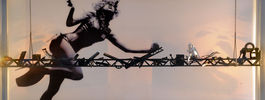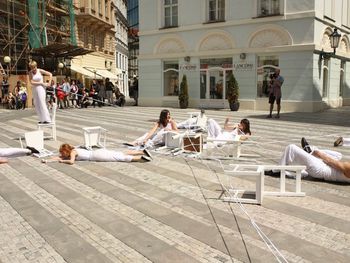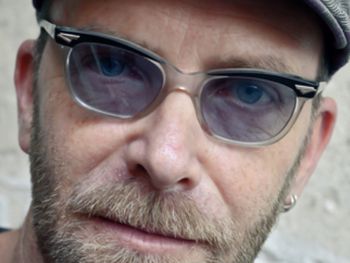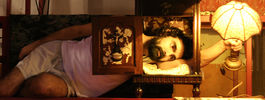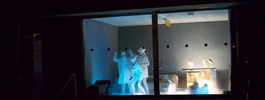

1979 » Norway » Stage and costume design
NORSKO
Norwegian Stage Design Before the year 1930 Norwegian fine art was in no way remarkable. It suffered from academism and a lack of vitality and was more or less a reflection of European models which were adapted to the tastes of the bourgeoisie. Nevertheless, something was in the making. Our oldest history was so dramatic, our folklore so rich and our natural environment so exceptional, that suddenly all artists were captured by a mighty wave of patriotism. The most significant period in the history of Norwegian art began with what we call the period of national romanticism. The young Ibsen, living in poverty, wanted to become a painter and was literally the first to undertake a journey of discovery throughout his native country, armed only with a pen and notebook. His first plays were picture stories from Norwegian sagas. In Ibsen s later plays - Peer Gynt, Brand Rosmersholm and the Lady From the Sea - the characters are not only influenced, but literally become part of the endless fjords, narrow valleys, wild rivers, waterfalls and the endless sea coast of our country. Ibsen's social dramas are realistic reflections of the safe and closed homes of the bourgeoisie, full of worldly goods and the decorative symbols of their social status. Ibsen had two basic demands concerning the staging of his plays: They should strive either to heights and depths - with unlimited imagination, or they should build on the greatest possible number of details and thus produce absolute realism. From the time when Ibsen worked as a stage director, we have not only his own sketches for stage sets, but also the plans for the layout of the stage, which are very carefully executed. Ibsen opened a new era in the staging of drama. The actors began to play among themselves within the decoration, instead of merely reciting their roles in the direction of the audience, in front of the decorations. I would go so far as to say that Ibsen, who became the greatest playwright of our times, is also the most significant and most inspiring factor in the development of Norwegian stage design} this is so not only because he rejected the existing standard sets of Danish origin, but also because he took into consideration psychological aspects and was convinced that the characters in the play are formed by their environment and moreover, that the performance to a great extent depends upon its visual aspects. The first Norwegian stage designer, working in the Christiania Theatre /1889/, designed the stage sets for a number of Ibsen's dramas, and as we know, the playwright was satisfied with the results. But what he saw was a picture stage, rigid under the influence of a tradition going all the way back to the Baroque era. Today we look upon photographs of these stage designs from the turn of the century with nostalgia forbearance. Indoor sets have high fiat walls made of fabric} doors, curtains and friezes are painted on the set, while light and shade are cleverly stressed by the painting. Outdoor sets have the same fiat tree trunks with cut-out leaves} they are placed in profile, as lateral scenery. There is one thing we must admit: these designers really were masters of their craft. The paintbrush was for the designer an extension of his own hand. Our artists have always been in close contact with the foremost artistic centers of Europe - above all with France and Germany and they were understandably influenced by the most varied "-isms", the majority of which later also flowered in our cold Norwegian climate. When in 1906 Max Reinhardt decided to open a new theatre in Berlin with Ibsen's drama Ghosts, to honor the memory of the playwright who had died that same year, he asked Edvard Munch to design the stage sets. The result was what was probably the first symbolist stage design in Europe. Until his death Munch in his dramatic paintings was preoccupied with Ibsen s characters and their symbolic significance. Our two foremost theatrical buildings, The National Theatre in Oslo and the National Stage in Bergen, were both built at the turn of the century. Both these theatres have rather large stages with modern technical and lighting facilities. These facts have provided broad possibilities, but at the same time they placed new technical demands upon stage designs. Those few artists who became professional stage designers had some knowledge of the revolutionary theories being implemented by Appius, Craige and Saxe - Meiningen. Stairs and patches of various colors and sizes were placed on the stage proportionally and in mutual relation, thereby extending a two-dimensional scenic picture and transforming it, to an increasing extent, into three-dimensional plastically formed scenic space. During the thirties it was more or less the usual thing for foremost painters in Norway to design stage decorations, mostly for specific, selected performances. With some exceptions, the results were always such, as could be expected. Too much stress was placed on decorative elements and decorations became magnified pictures, painted in solid "natural ' colours. Only after World War II did a fundamental change take place and stage designers won their own independent creative prestige, which is a necessary prerequisite for a relationship of equality with the stage director and thus also for foreign the artistic unity of the performance. Since this time, Norwegian stage design has proven that it has strong roots in the realism of life, but that at the Same time, we are easily influenced by all types of art and by impulses from the whole world. We have accepted almost all forms of scenic expression - from pure abstract constructivism up to a lonely chair ' against a black background. As professional stage designers we are no better and no worse than our colleagues elsewhere. We accept and borrow ideas and thoughts and we transform their for our own use. I must, however, on behalf of all of us say that we try to do so discreetly and honorably. We have an Association, which has a membership of approximately 50 stage and costume designers. Entry into the profession can be achieved either through practical experience or by studying at an art school. Several students have obtained specialized training abroad. About fifteen of us work permanently for various state or municipal theatres. Another group works for Norwegian Television and several designers work predominantly for films. The remainder are free lance artists. In recent years stage designing is becoming fashionable – many art students are fascinated by Thalia. In view of the fact that our theatres often invite colleagues from abroad competition is stiff. It should continue to be so. To design good stage sets is no easy matter.
